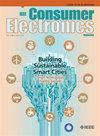Cloud-Edge Collaborative Scalable Tucker-Based Tensor Computations for Ubiquitous Consumer Electronics Data
IF 10.9
2区 计算机科学
Q1 ENGINEERING, ELECTRICAL & ELECTRONIC
引用次数: 0
Abstract
With the continuous expansion of consumer electronics applications, various data generated from ubiquitous consumer electronics devices are experiencing exponential growth. By leveraging the significant advantages of multidimensional association analysis, tensor-based big data technology has proven effective in uncovering hidden patterns within these data. However, the curse of dimensionality severely restricts the widespread exploitation of tensors, particularly on edge devices with limited computing and storage capabilities under cloud-edge computing environments. To address this challenge, we propose a series of cloud-edge collaborative scalable Tucker-based tensor computations to effectively analyze these ubiquitous data. First, we present a set of Tucker-based tensor operations that transform high-order and large-scale tensor operations into multiple low-order and small-scale operations while preserving the equivalence of their results. Then, we present a scalable Tucker-based computation architecture to adapt to the cloud-edge computing paradigm, including scalable inter-Tuckercore and intra-Tuckercore models. Furthermore, we implement some typical Tucker-based tensor computations based on various scalable models and analyze their complexity in detail. Finally, extensive evaluations on both synthetic and real-world datasets demonstrate that the proposed scalable Tucker-based tensor computation method significantly improves computational efficiency, achieving an average efficiency improvement of 2 to 5 times compared to serial computation. These results confirm its suitability for cloud-edge collaboration to process ubiquitous consumer electronics data.无所不在的消费电子数据的云边缘协作可扩展的基于tucker的张量计算
随着消费电子应用的不断扩大,无处不在的消费电子设备产生的各种数据正在呈指数级增长。通过利用多维关联分析的显著优势,基于张量的大数据技术已被证明在发现这些数据中的隐藏模式方面是有效的。然而,维度的诅咒严重限制了张量的广泛利用,特别是在云边缘计算环境下计算和存储能力有限的边缘设备上。为了应对这一挑战,我们提出了一系列基于塔克的云边缘协作可扩展张量计算来有效地分析这些无处不在的数据。首先,我们提出了一组基于tucker的张量运算,将高阶和大规模张量运算转换为多个低阶和小规模运算,同时保持其结果的等价性。然后,我们提出了一个可扩展的基于tucker的计算架构,以适应云边缘计算范式,包括可扩展的inter-Tuckercore和intra-Tuckercore模型。在此基础上,我们实现了一些典型的基于塔克的张量计算,并详细分析了它们的复杂度。最后,对合成数据集和实际数据集的广泛评估表明,所提出的基于tucker的可扩展张量计算方法显著提高了计算效率,与串行计算相比,平均效率提高了2至5倍。这些结果证实了它适合于云边缘协作来处理无处不在的消费电子数据。
本文章由计算机程序翻译,如有差异,请以英文原文为准。
求助全文
约1分钟内获得全文
求助全文
来源期刊
CiteScore
7.70
自引率
9.30%
发文量
59
审稿时长
3.3 months
期刊介绍:
The main focus for the IEEE Transactions on Consumer Electronics is the engineering and research aspects of the theory, design, construction, manufacture or end use of mass market electronics, systems, software and services for consumers.

 求助内容:
求助内容: 应助结果提醒方式:
应助结果提醒方式:


